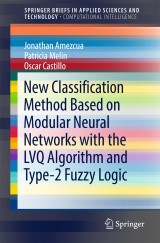Details

New Classification Method Based on Modular Neural Networks with the LVQ Algorithm and Type-2 Fuzzy Logic
SpringerBriefs in Applied Sciences and Technology
|
53,49 € |
|
| Verlag: | Springer |
| Format: | |
| Veröffentl.: | 05.02.2018 |
| ISBN/EAN: | 9783319737737 |
| Sprache: | englisch |
Dieses eBook enthält ein Wasserzeichen.
Beschreibungen
<p>In this book a new model for data classification was developed. This new model is based on the competitive neural network Learning Vector Quantization (LVQ) and type-2 fuzzy logic. This computational model consists of the hybridization of the aforementioned techniques, using a fuzzy logic system within the competitive layer of the LVQ network to determine the shortest distance between a centroid and an input vector. This new model is based on a modular LVQ architecture to further improve its performance on complex classification problems. It also implements a data-similarity process for preprocessing the datasets, in order to build dynamic architectures, having the classes with the highest degree of similarity in different modules. Some architectures were developed in order to work mainly with two datasets, an arrhythmia dataset (using ECG signals) for classifying 15 different types of arrhythmias, and a satellite images segments dataset used for classifying six different types ofsoil. Both datasets show interesting features that makes them interesting for testing new classification methods.</p> <p> </p>
Introduction.- Theory and Background.- Problem Statement.- Proposed Classification Method.- Simulation Results.- Conclusions.
<p>In this book a new model for data classification was developed. This new model is based on the competitive neural network Learning Vector Quantization (LVQ) and type-2 fuzzy logic. This computational model consists of the hybridization of the aforementioned techniques, using a fuzzy logic system within the competitive layer of the LVQ network to determine the shortest distance between a centroid and an input vector. This new model is based on a modular LVQ architecture to further improve its performance on complex classification problems. It also implements a data-similarity process for preprocessing the datasets, in order to build dynamic architectures, having the classes with the highest degree of similarity in different modules. Some architectures were developed in order to work mainly with two datasets, an arrhythmia dataset (using ECG signals) for classifying 15 different types of arrhythmias, and a satellite images segments dataset used for classifying six different types ofsoil. Both datasets show interesting features that makes them interesting for testing new classification methods.</p> <p> </p>
Develops a new model for data classification Presents a data classification model that is based on the competitive Neural Network Learning Vector Quantization (LVQ) and type-2 fuzzy logic

















